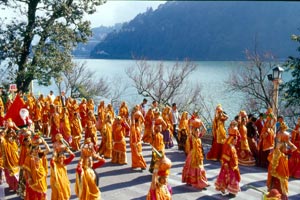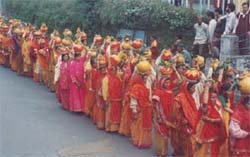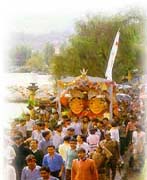|
FAIRS
AND FESTIVALS OF NAINITAL, KUMAON & UTTARAKHAND
Phooldeyi or Phooldeli
(Approx.14th March),
It is celebrated
in the months of March/April. On the occasion of Phooldei, young girls
put the first flowers of the season on the entrance or threshold of every
house in the village, for good luck throughout the year. This is a big
example of how communities are closely bonded and linked in the hills
of Kumaon as no one puts these flowers in front of their own houses alone.
Bikhauti
(Approx 14 April),
/On
the first of the navaratris (nine day fasting period) in the month of
Chaitra, women sow seven types of grains. The germination of these grains
symbolizes the future harvest. On the tenth day, the yellow leaves, called
Harela, are cut people put them on their heads and tuck them behind their
ears. During this very month of Chaitra (March-April) brothers send gifts
for their sisters. These presents are called ‘Bikhauti’
Hariyala
- Harela (Approx 16th July),
Celebrated
in the month of Shravan (July- august), the month of festivals, to commemorate
the wedding of Lord Shiva and Parvati, the festival is also associated
with the arrival of the rainy season and the new harvest. On this day
people make clay statues (Dikaras) of Shiva, Parvati, Ganesh etc. and
worship them. The overworked bullocks find a rare a rest on the occasion
of Harela.

Gheeya
Sankranti or Olgia
(Approx 16th Aug),
Olgia
is celebrated on the first day of Bhado (middle of August), when the harvest
is lush and green, vegetables are in abundance and the milch animals very
productive. In ancient times sons-in-law and nephews would give presents
to fathers-in-law and maternal uncles, respectively, in order to celebrate
Olgia. Today agriculturists and artisans give presents to the owners of
their land and purchasers of their tools and receive gifts and money in
return. Binai (oral harp), datkhocha (metallic tooth pick), metal calipers,
axes, ghee, vegetables and firewood are some of the presents exchanged
on this day. People put ghee on their foreheads and eat ghee and chapatis
stuffed with 'urad' dal. It is believed that walnuts sweeten after this
festival. This festival, which is a celebration of the produce of the
land, is now seldom celebrated.
Khatarua
(Approx 17th Sep.),
Khatarua
signifies the arrival of the autumn season, a very important time of the
year for the pastoral - agricultural society and is celebrated on the
first day of the month of Ashwin in mid September. Bonfires, around which
children dance, and offerings of cucumber to the fire of Khatarua mark
the celebrations. Cucumbers’ offerings, as is the popular belief, destroy
all evil influences.
Uttarani
or Kale
Kaua (Approx 14 January),
Held
on gigantic scales, the fair is held simultaneously at a number of places
like Nainital, Bageshwar, Rameshwar, Salt Mahadev, Chitrashila (Ranibagh),
Pancheshwar among others on the auspicious day of Uttarayani. The Dola
of Chaumu is brought down to the temple at Pancheshwar. The festival of
Uttarayani holds a special place in the culture of Uttarakhand, in general,
and Kumaon, in particular.
Basant
Panchami, Samvastar Pareva
Celebrated to commemorate the coming of the spring season and, also, the
end of winter, Basant Panchmi is generally celebrated during the traditional
month of Magh (January - February). People worship Goddess Saraswati,
use yellow clothes or handkerchiefs and, in a few places, people put a
yellow tilak on their foreheads. With this festival, the extremely popular
holi baithaks also begin.
|




